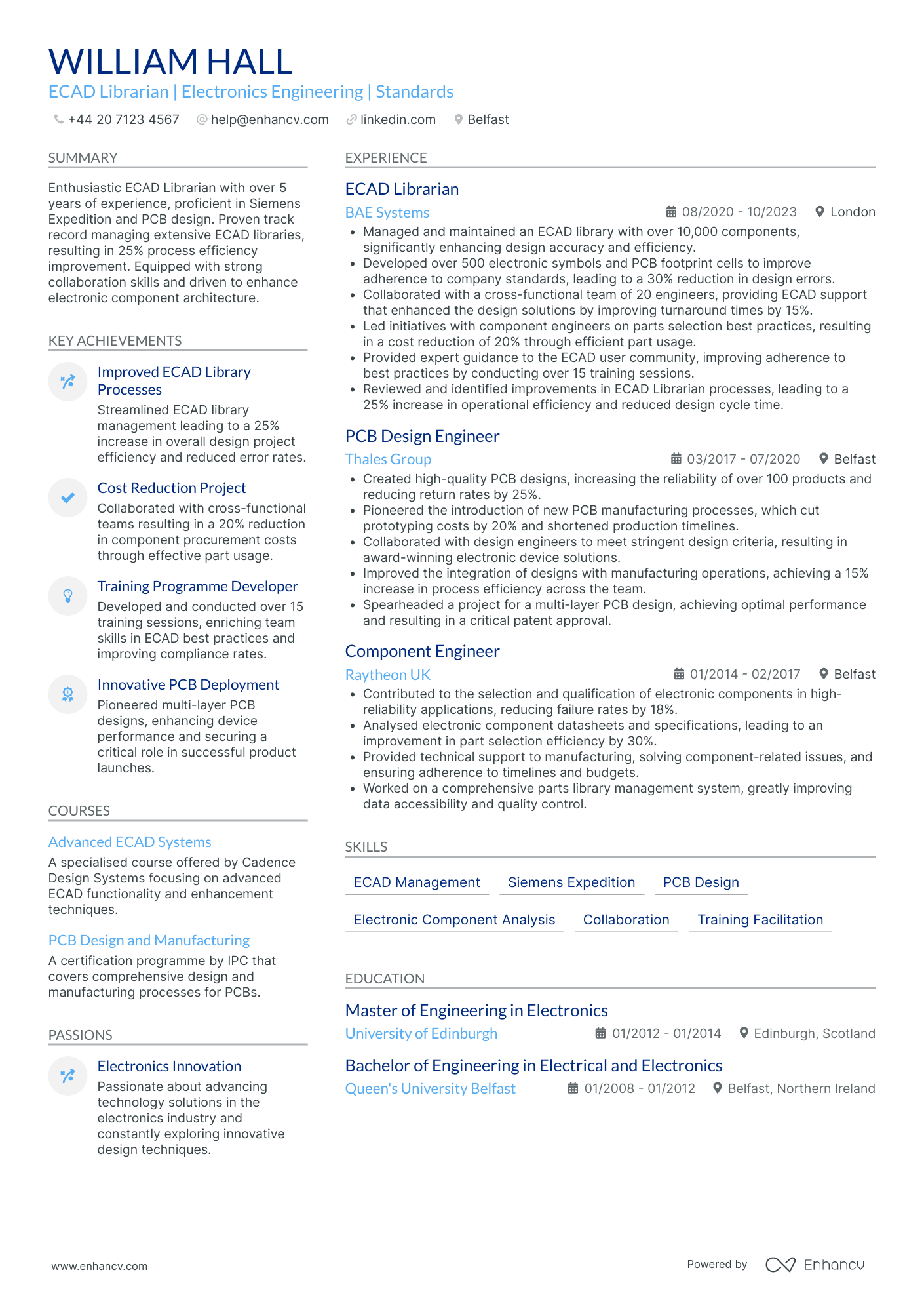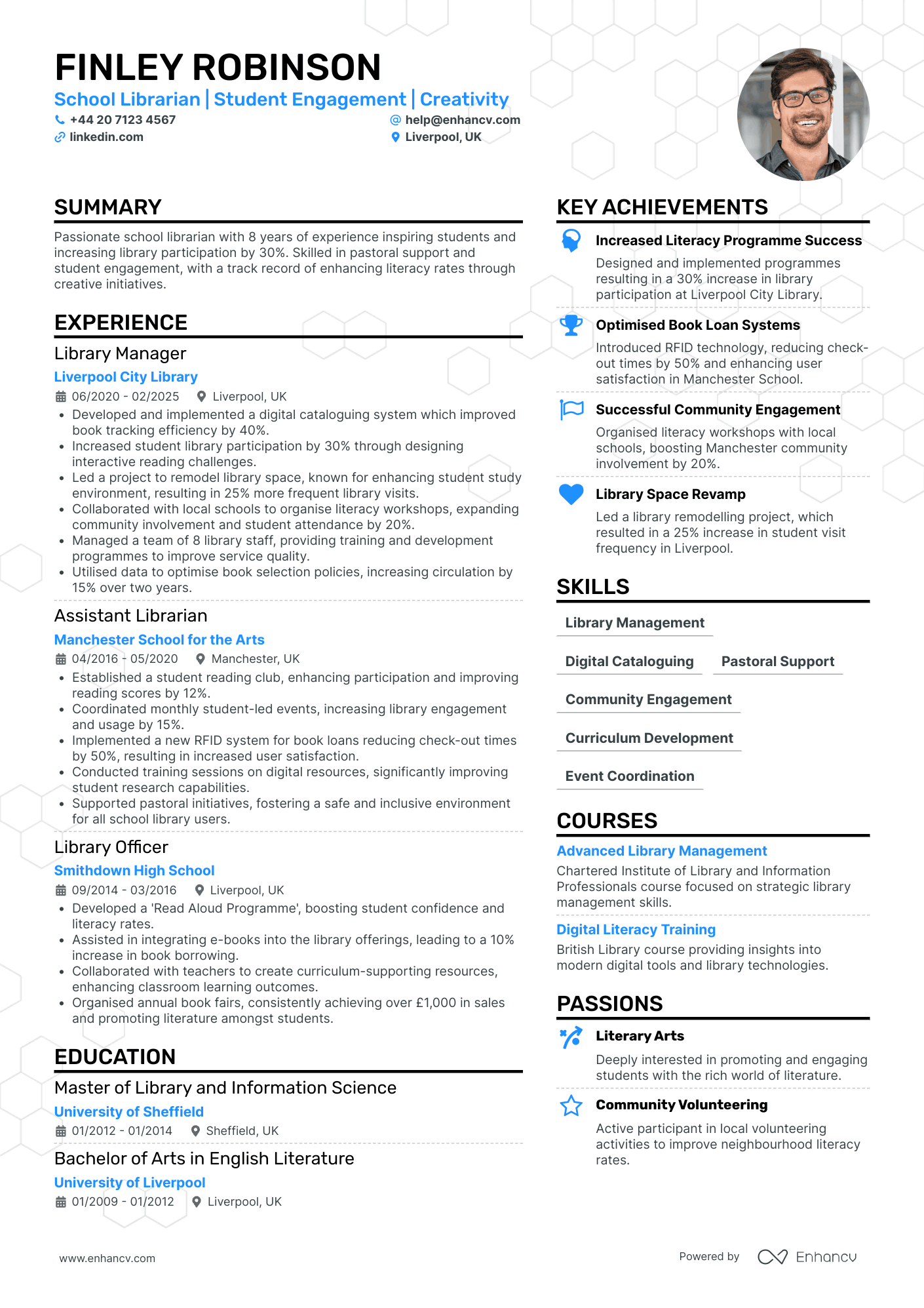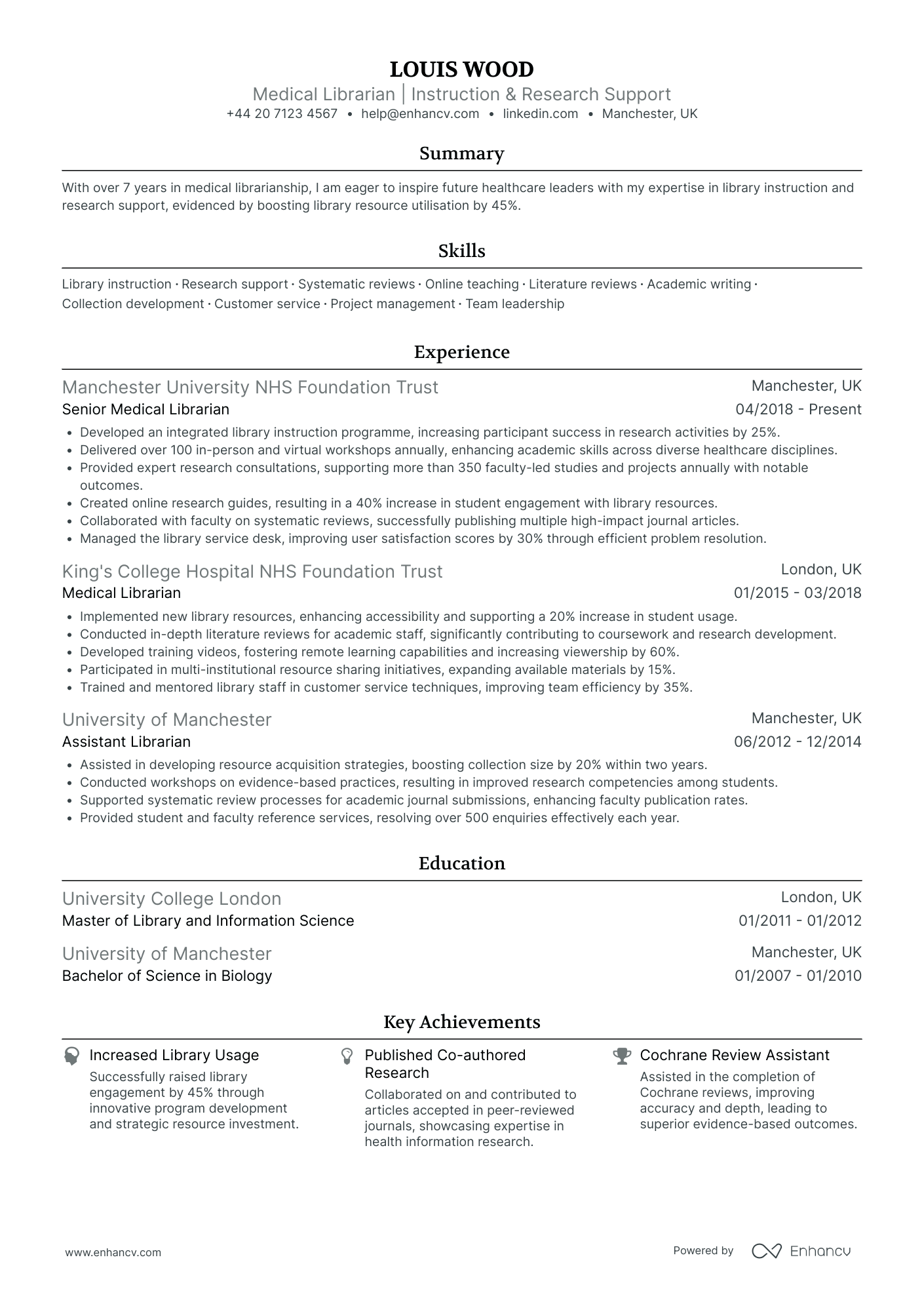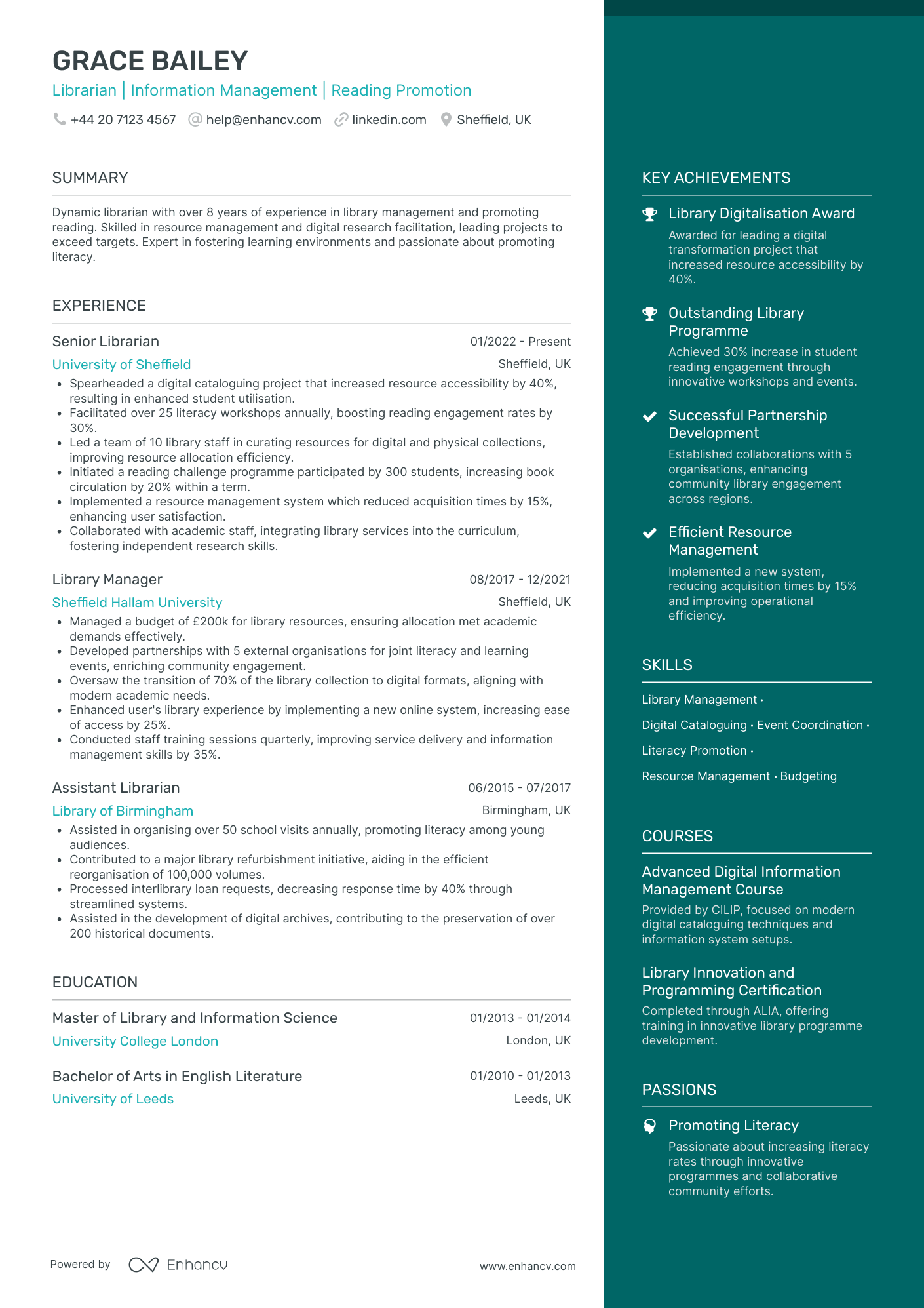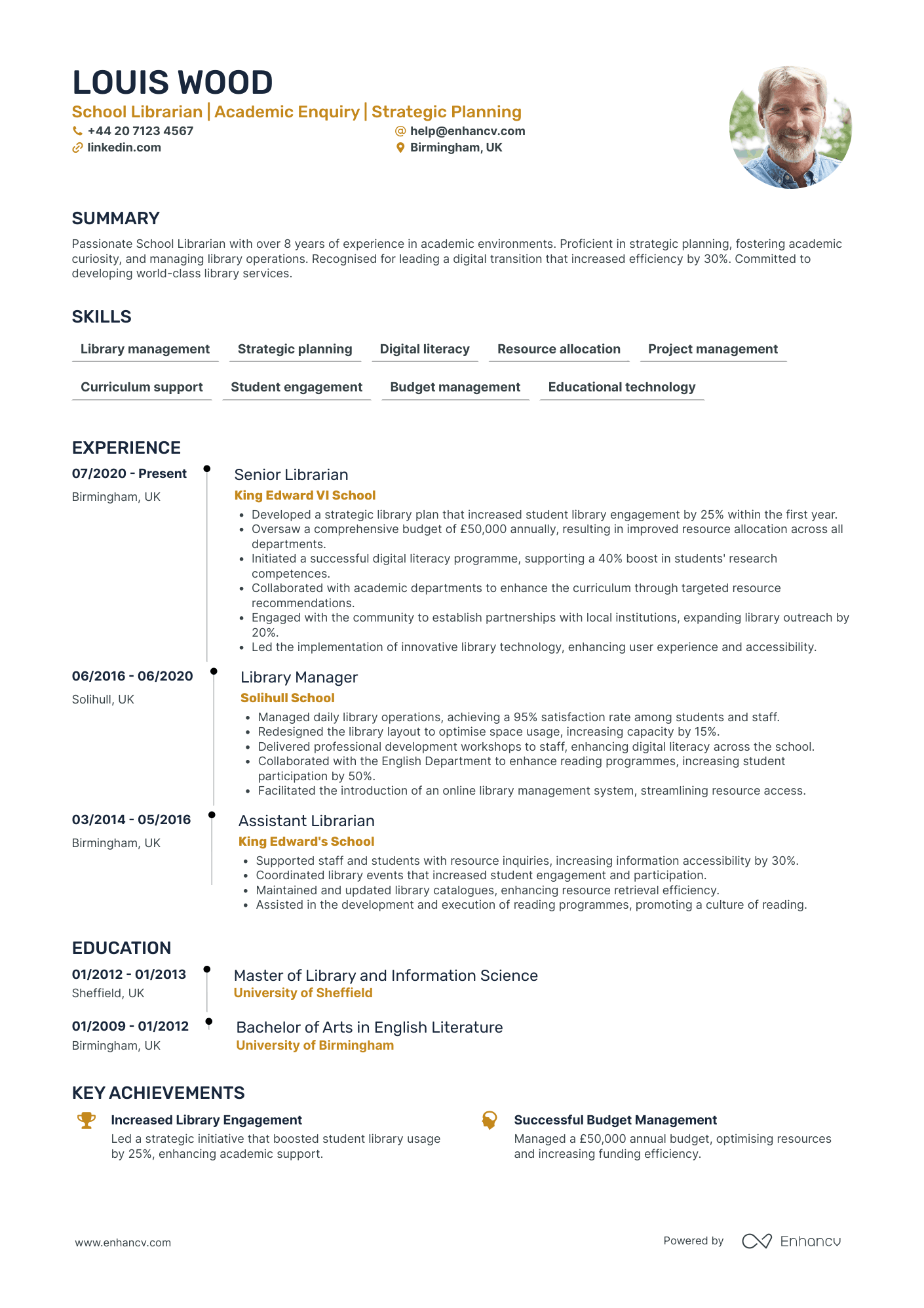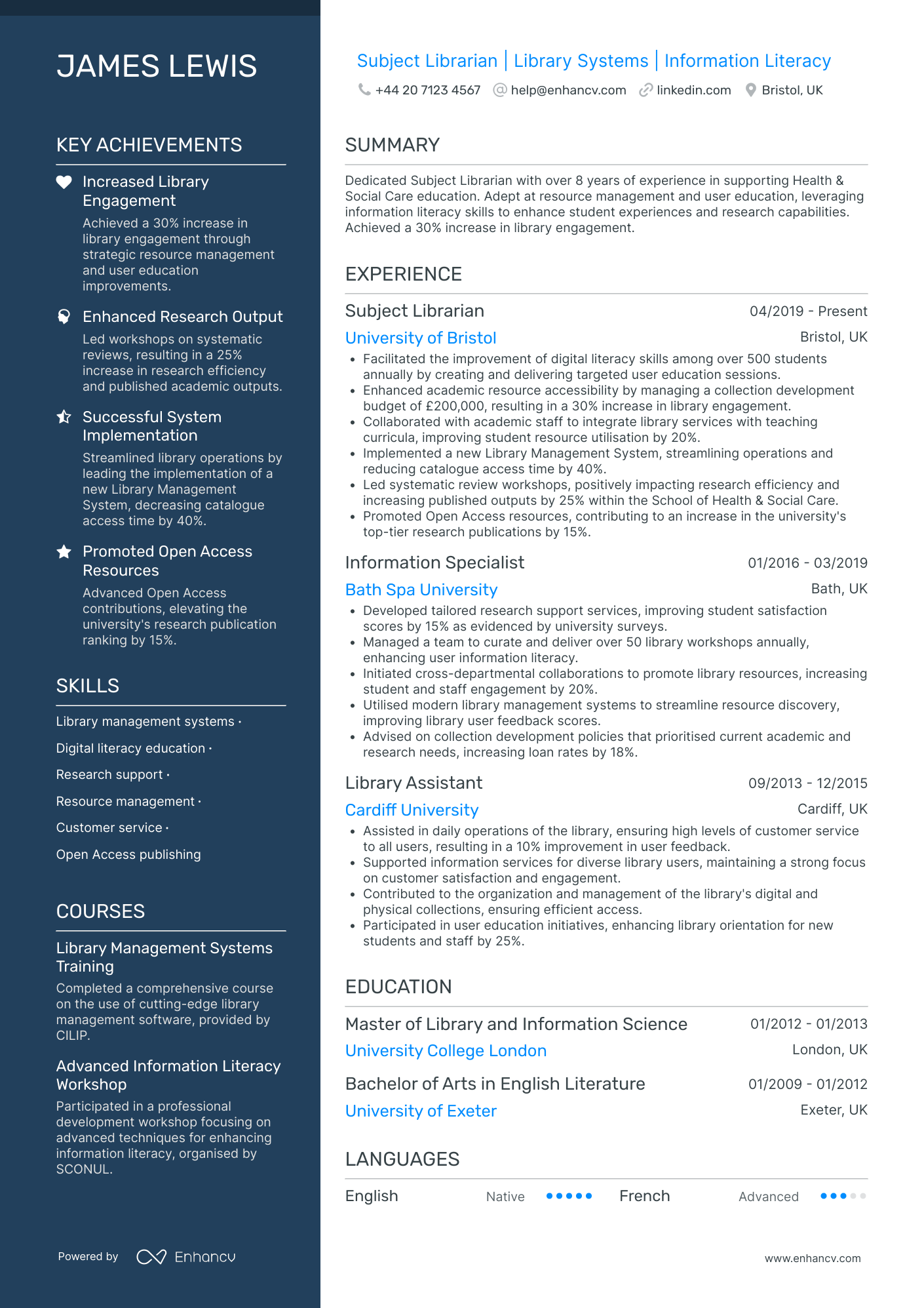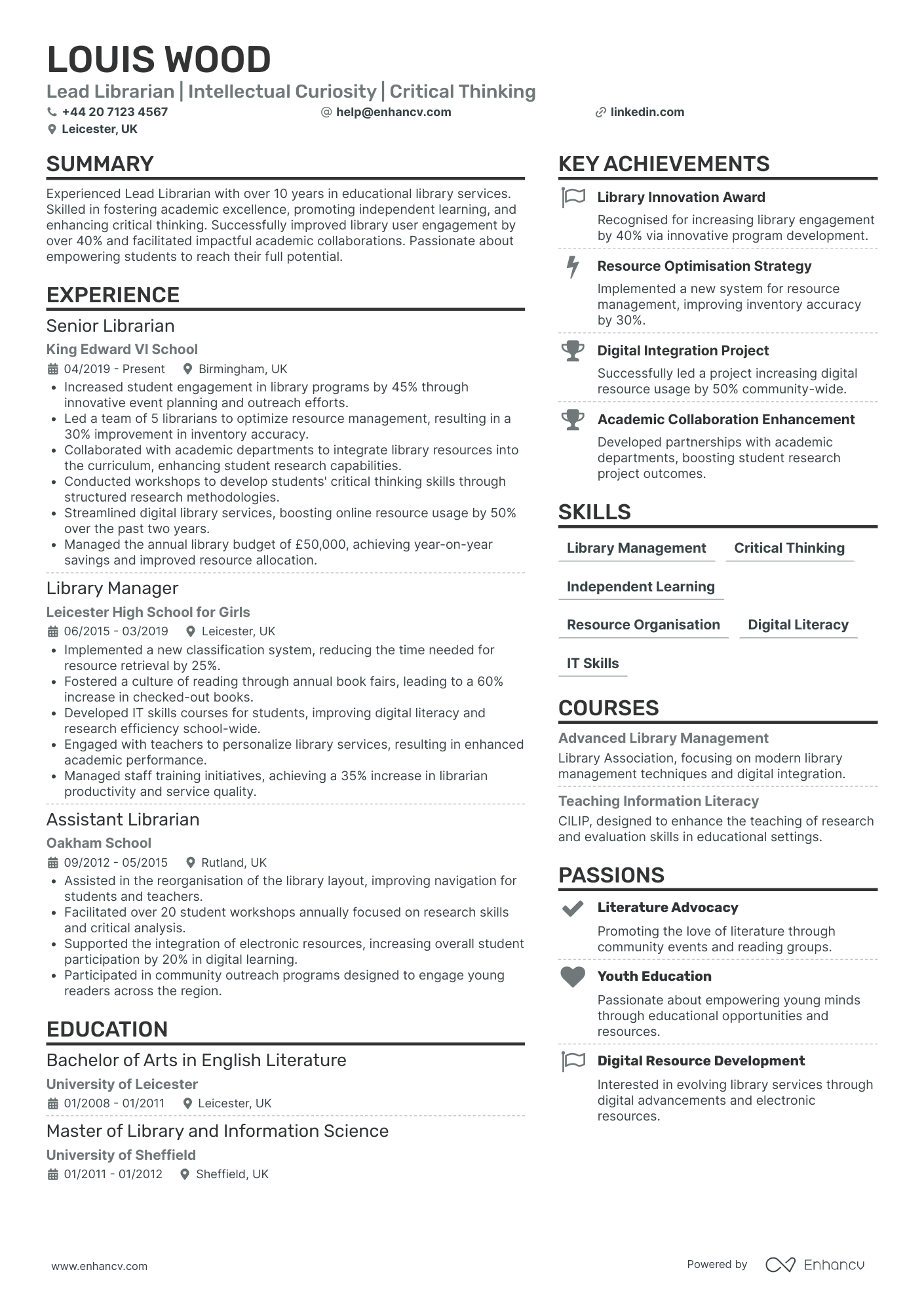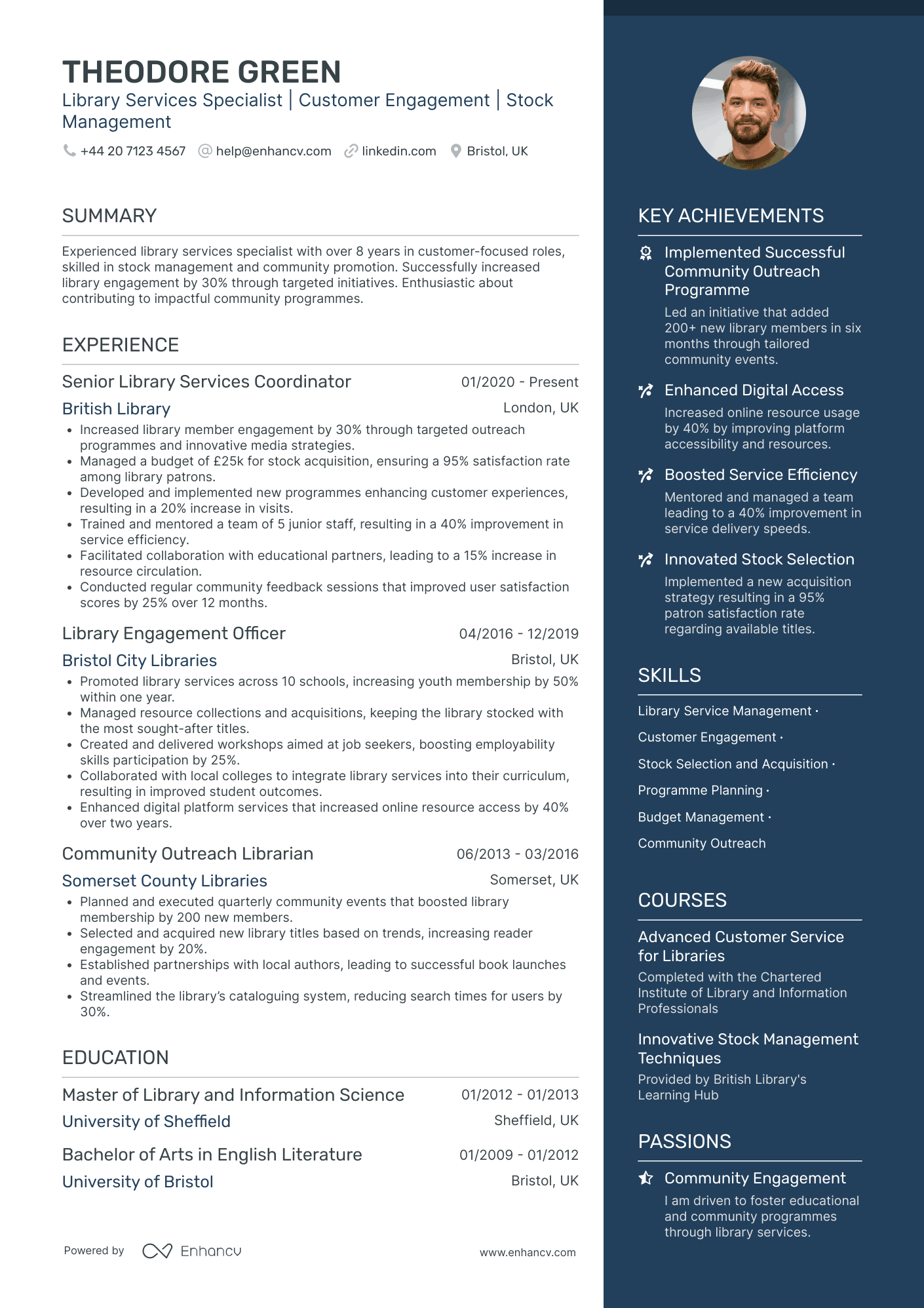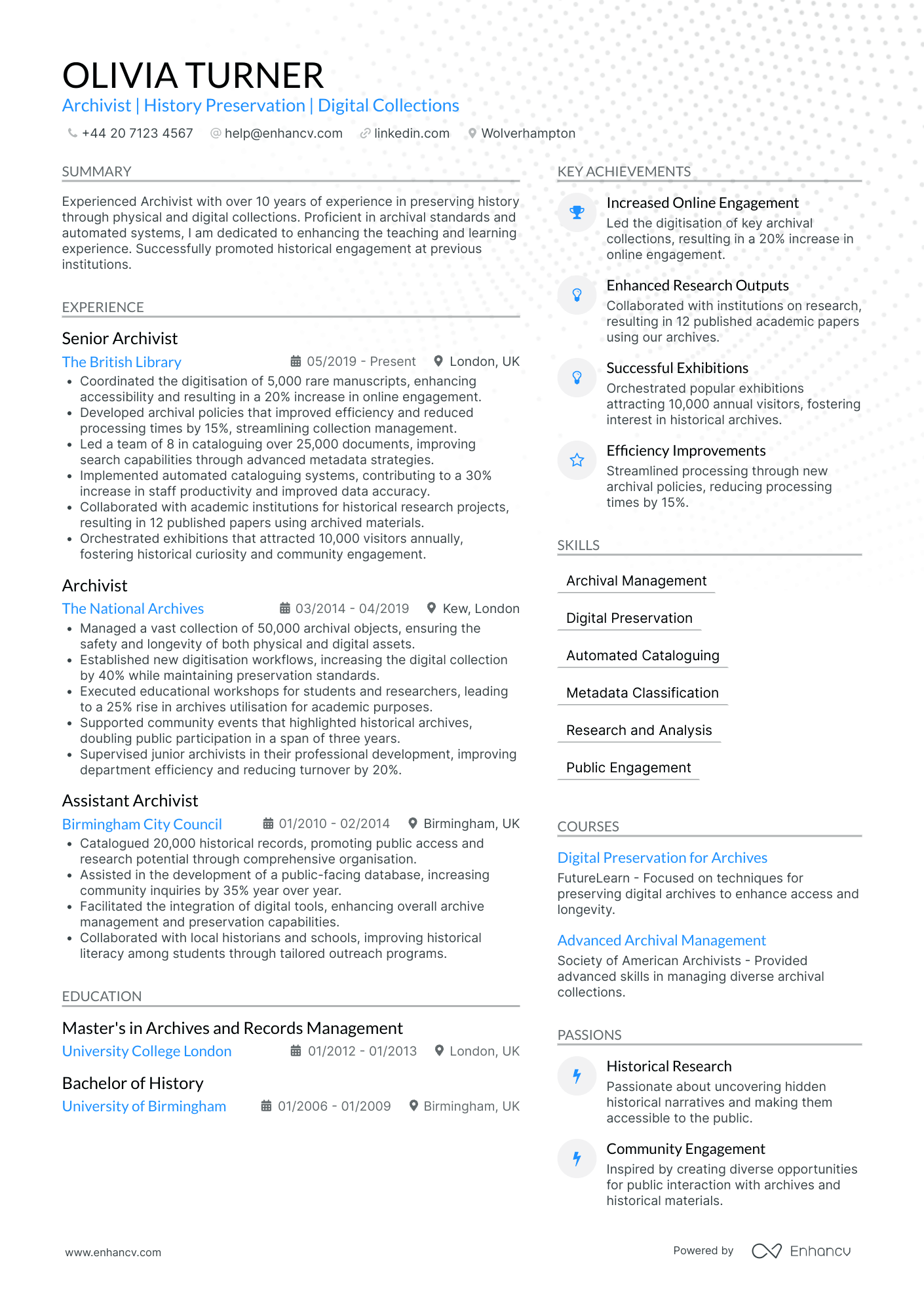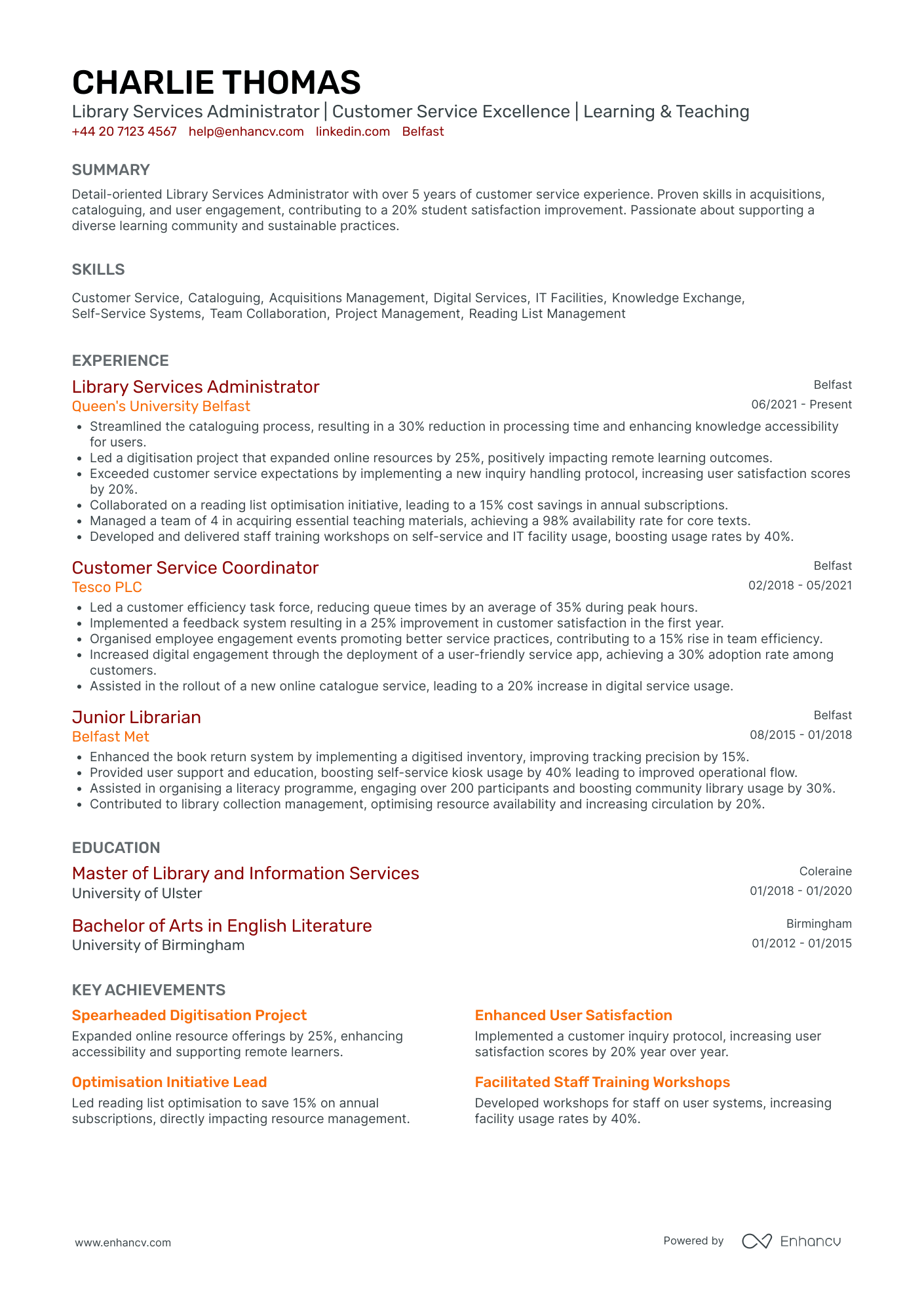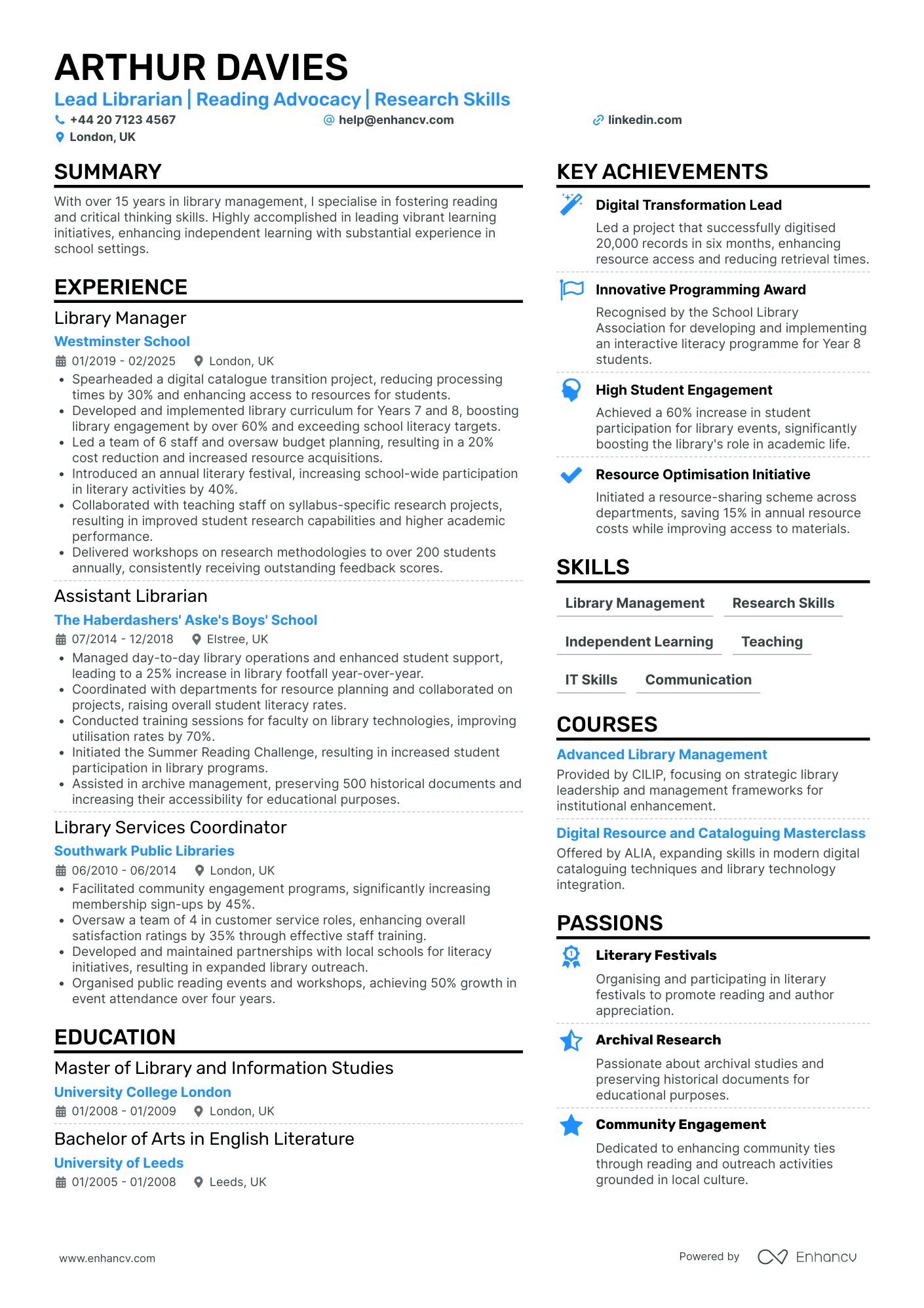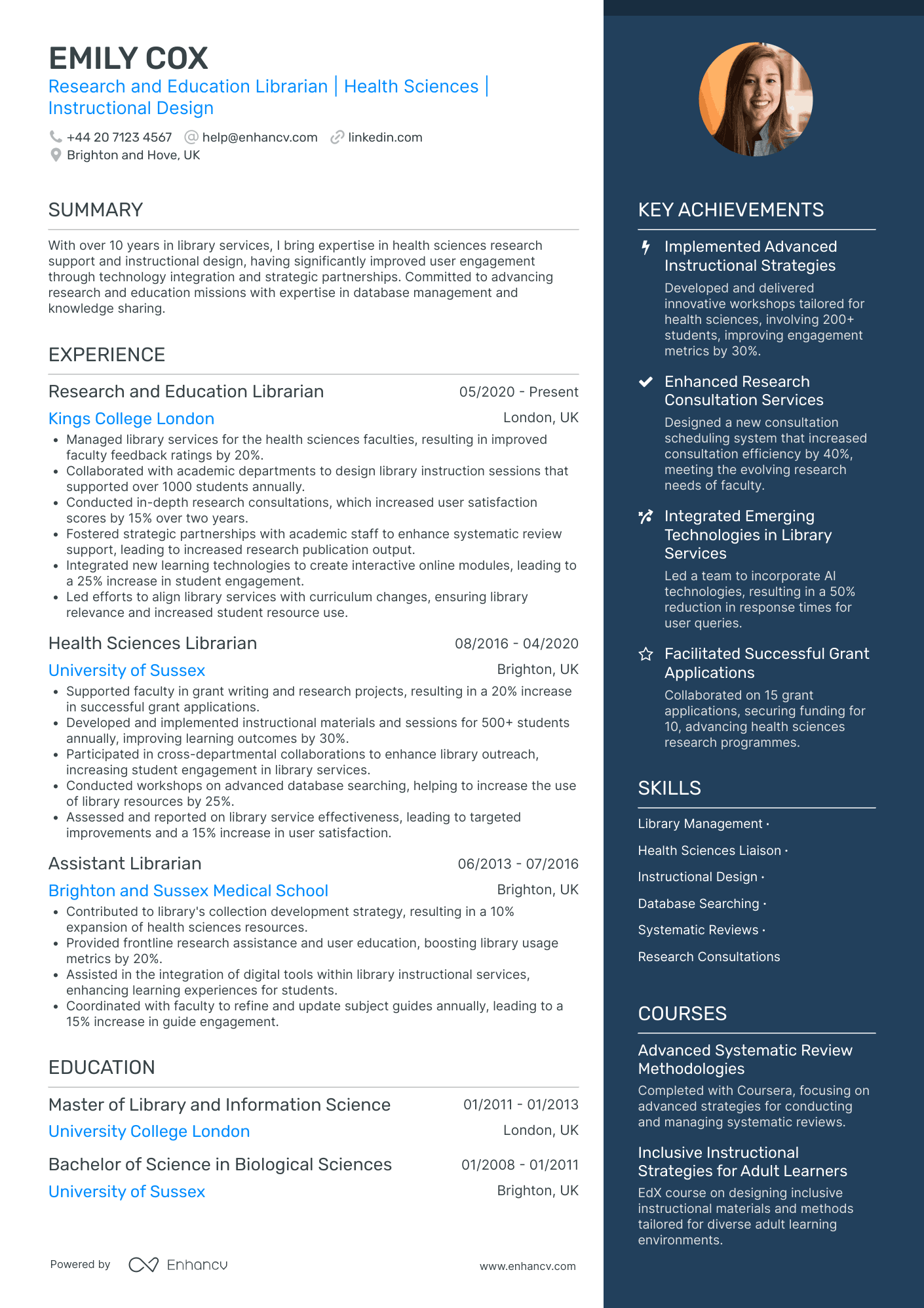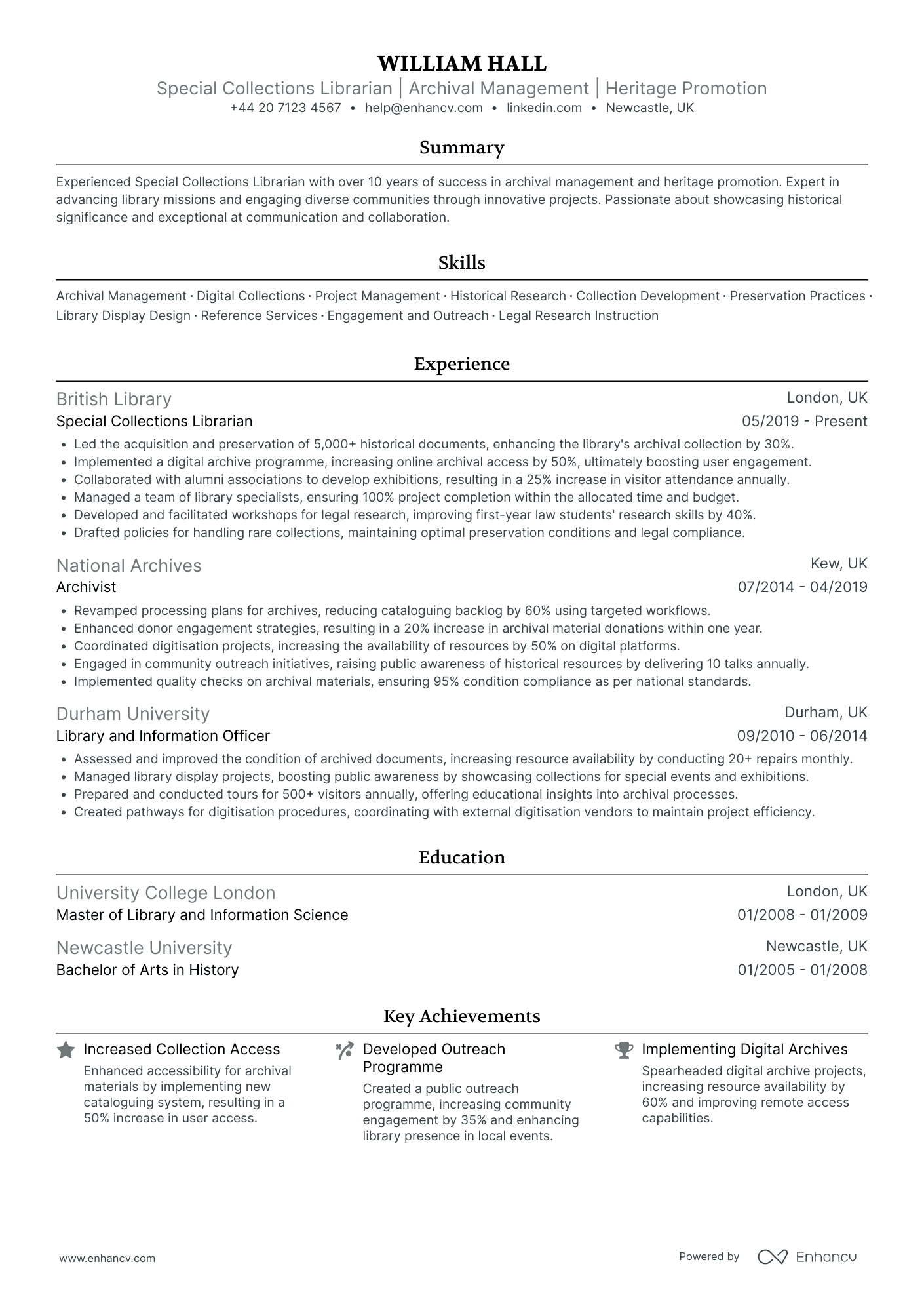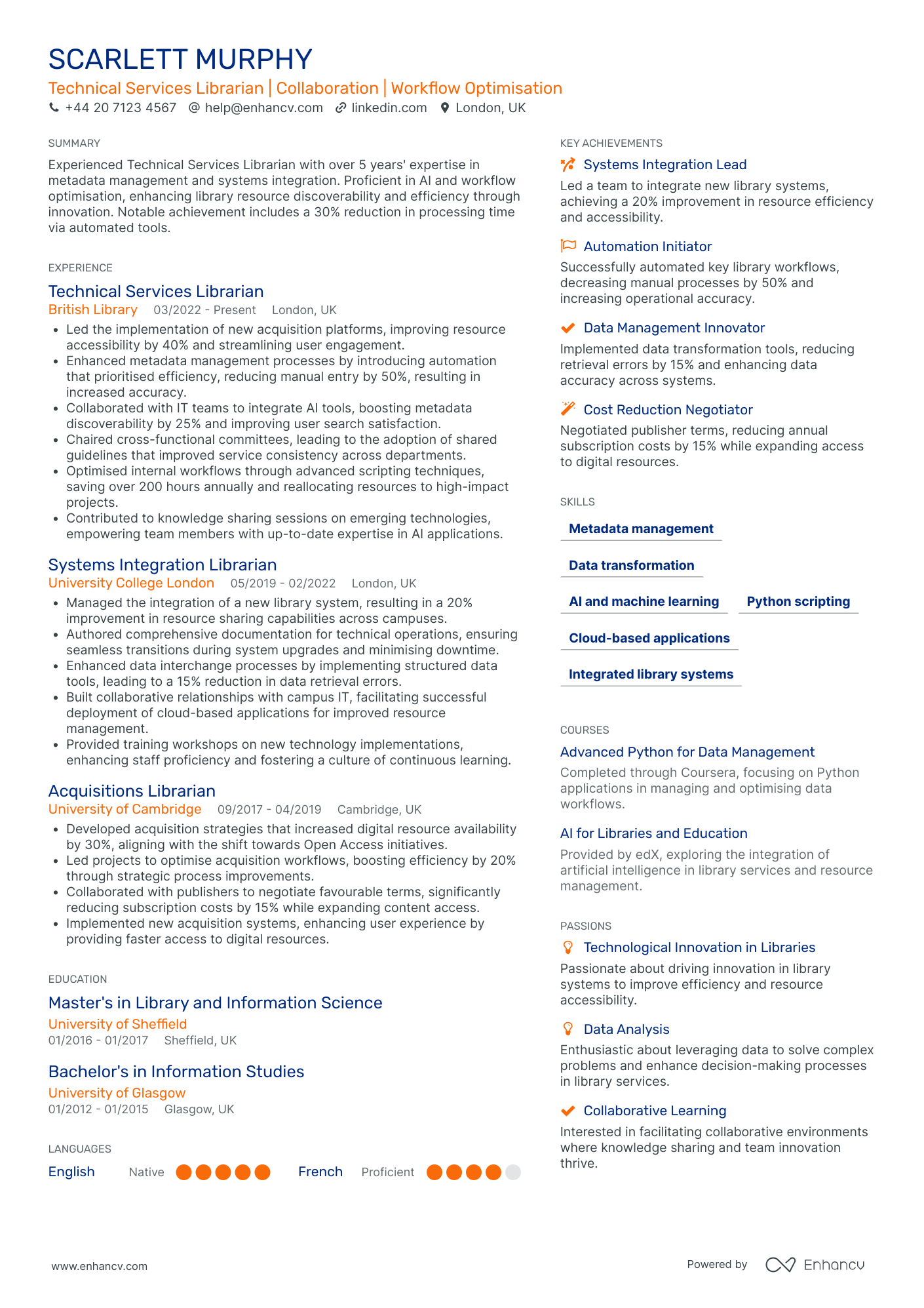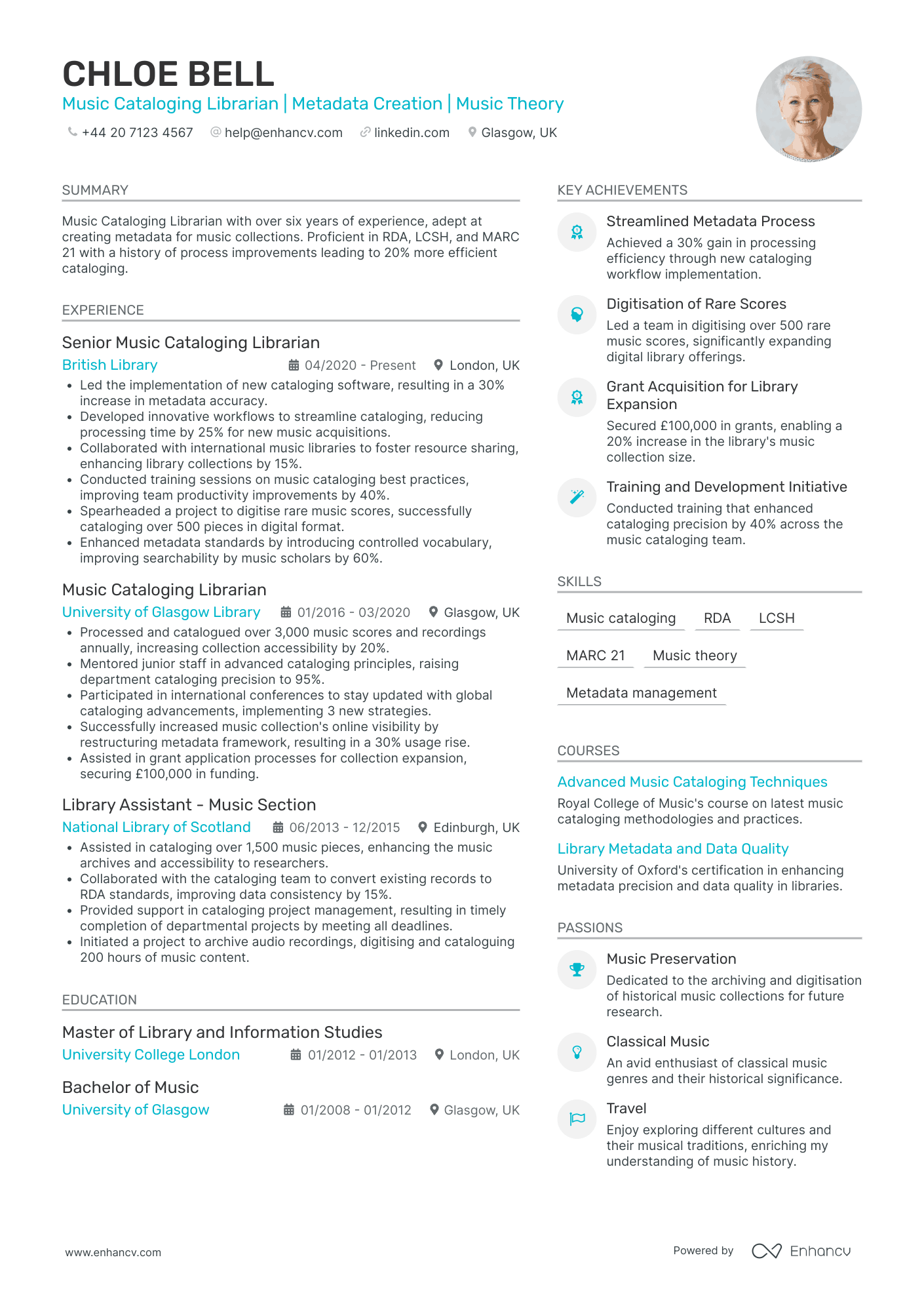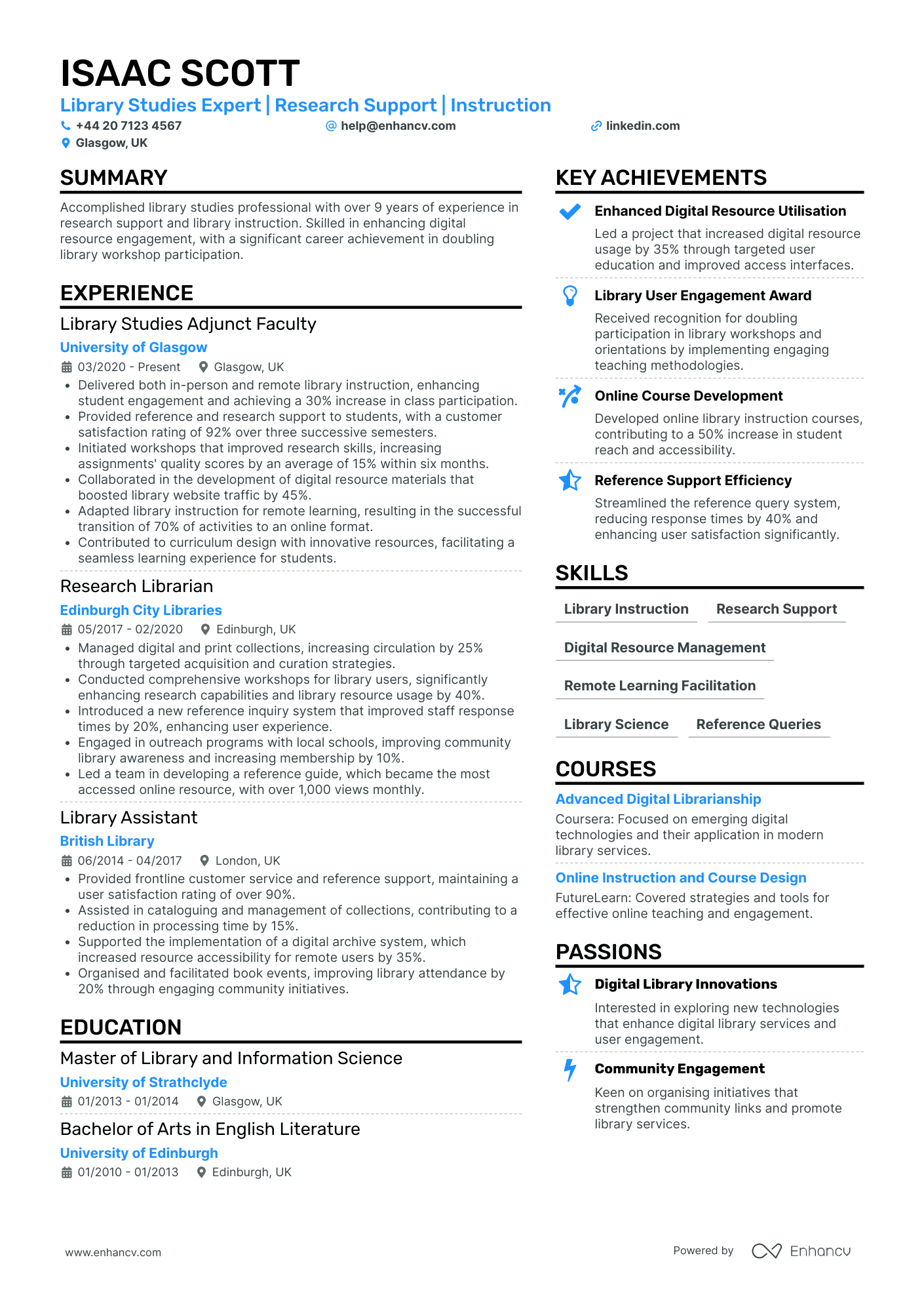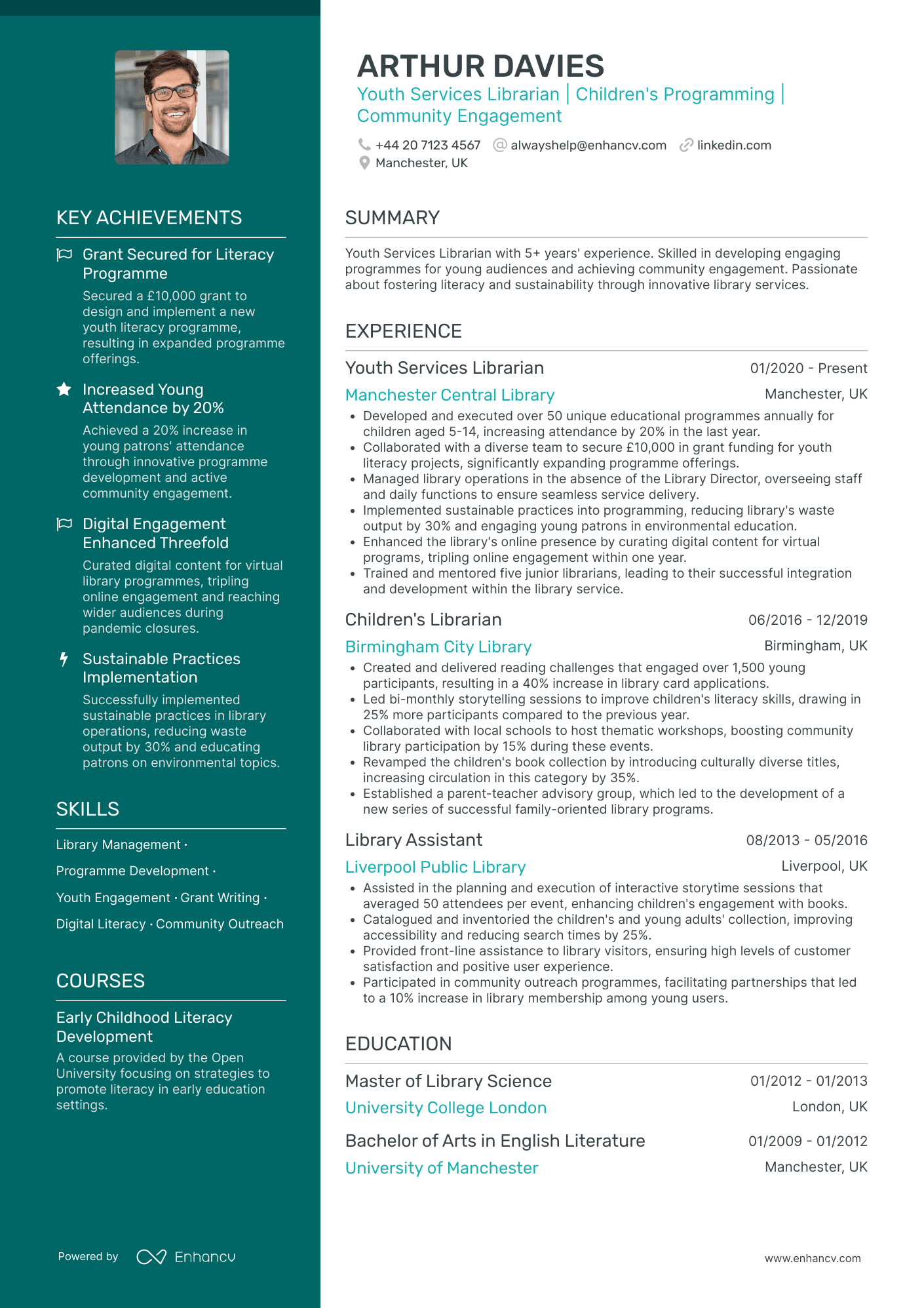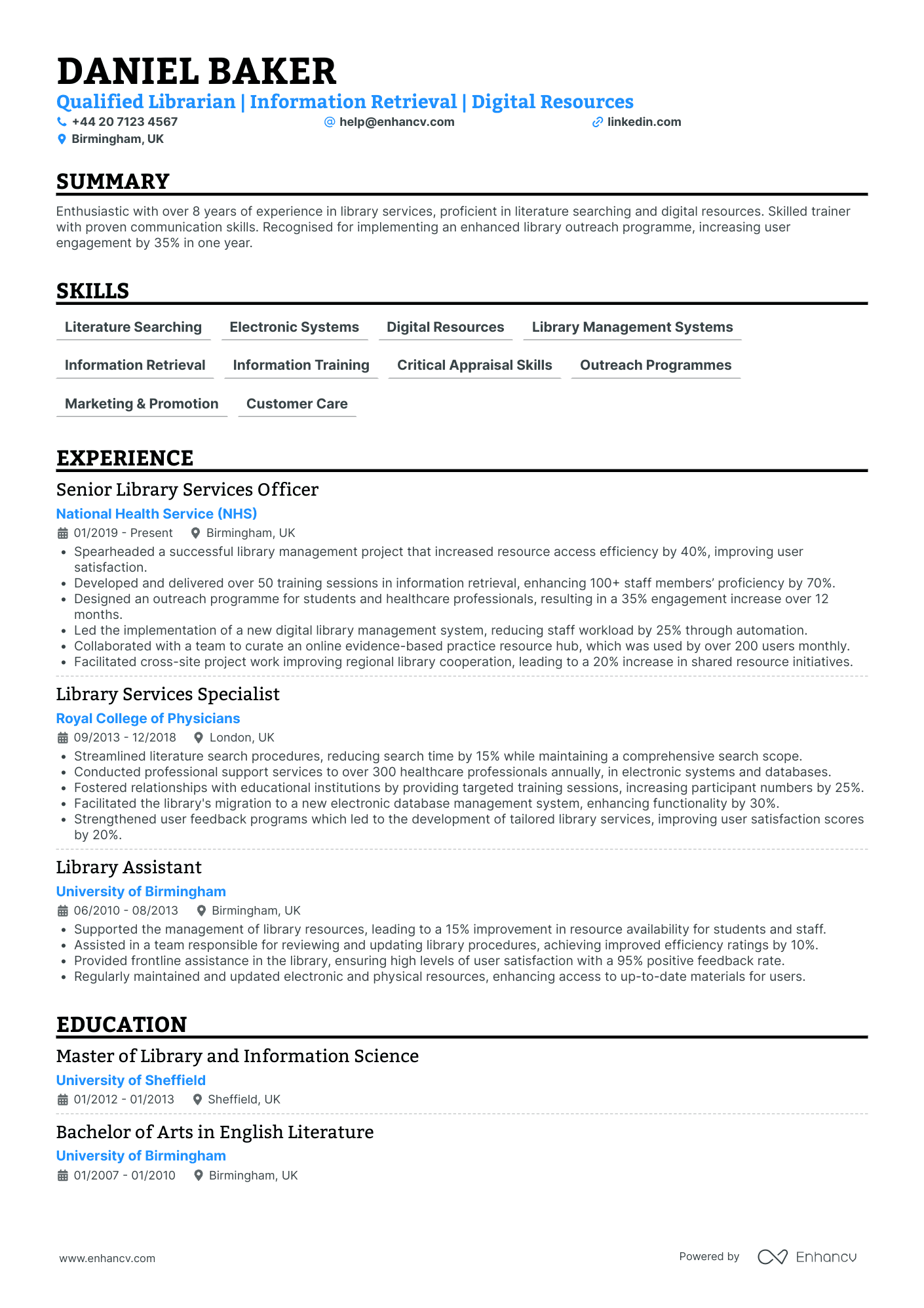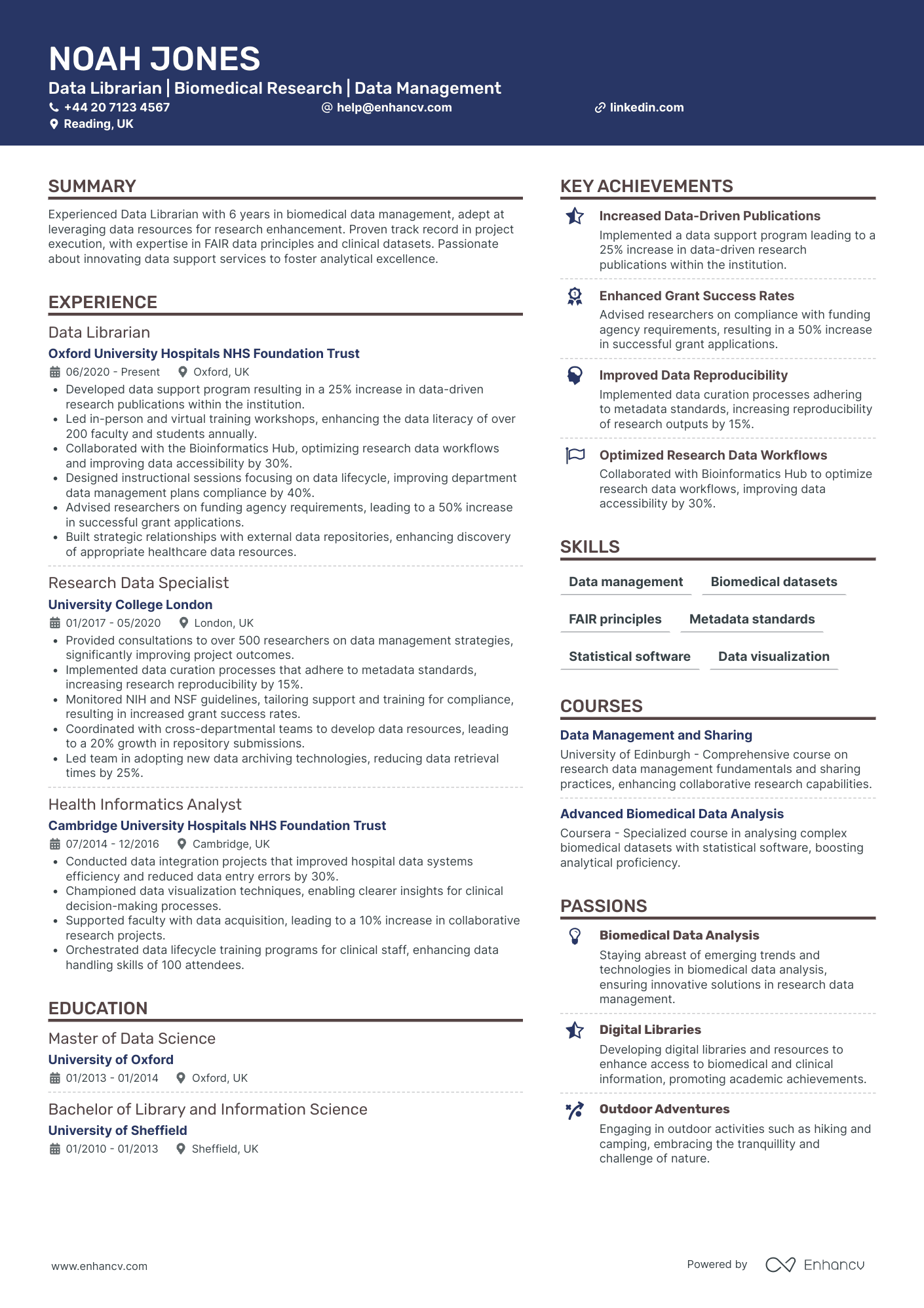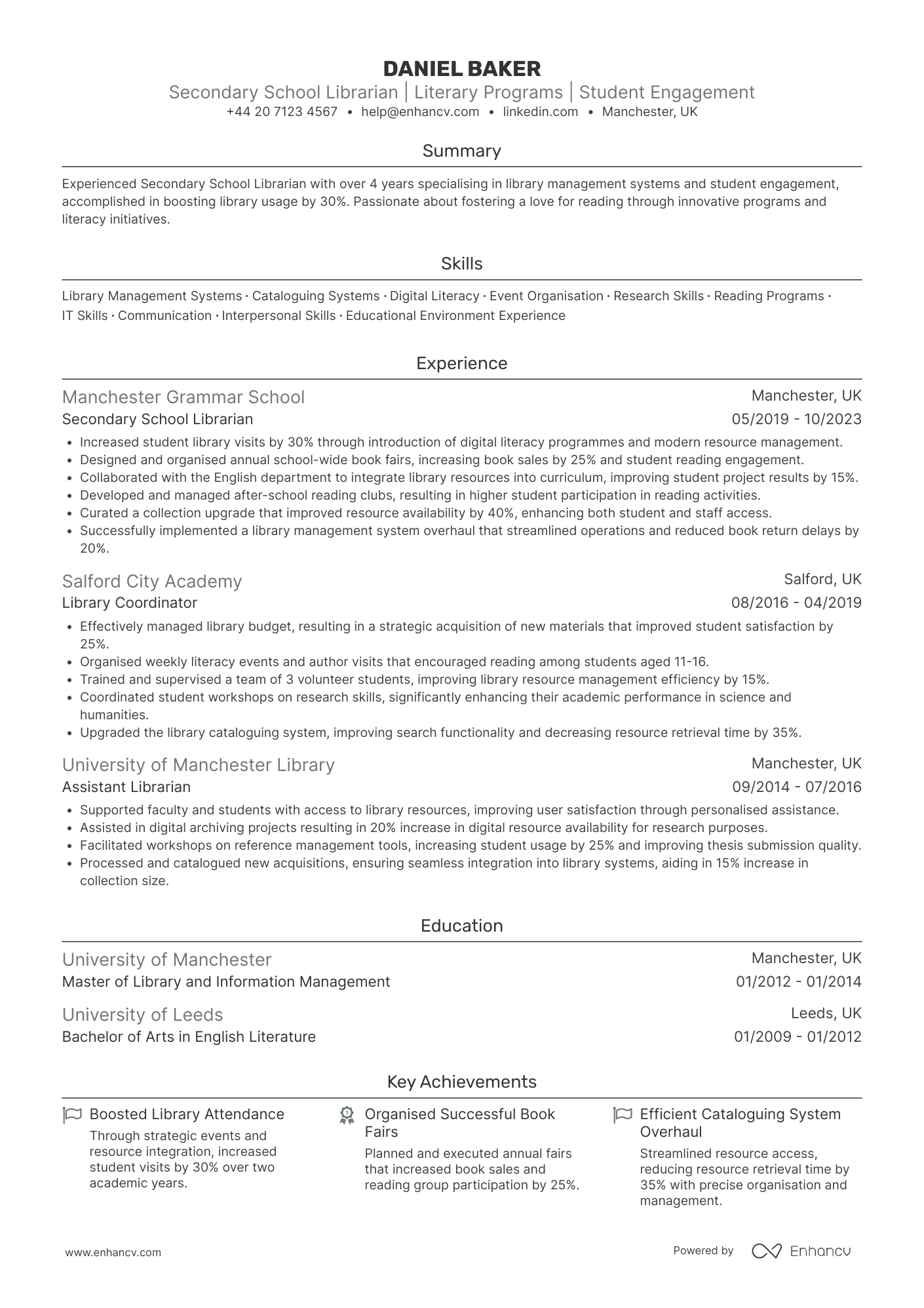Crafting your CV to stand out in a competitive library science field is an intimidating challenge. Our guide will offer strategies to showcase your archival expertise and digital literacy skills, ensuring a CV that captures the attention of potential employers.
- Applying best practices from real-world examples to ensure your profile always meets recruiters' expectations;
- What to include in your work experience section, apart from your past roles and responsibilities?
- Why are both hard and soft skills important for your application?
- How do you need to format your CV to pass the Applicant Tracker Software (ATS) assessment?
If you're writing your CV for a niche librarian role, make sure to get some inspiration from professionals:
CV examples for librarian
By Experience
Senior Librarian
- Career Trajectory and Progression - William Hall's career exhibits a clear upward trajectory, emphasizing his steady progress through engineering roles, growing from a Component Engineer at Raytheon UK to leading complex ECAD Librarian tasks at BAE Systems. Each role builds on his previous experiences, showcasing his dedication to professional development and mastery of increasingly complex responsibilities within electronics engineering.
- Technical Depth in Engineering Tools - The CV showcases William's deep expertise with specific industry tools and software, such as Siemens Expedition and PCB design. His ability to manage ECAD libraries and create PCB designs demonstrates not only technical proficiency but also a thorough understanding of electronic component architecture, making him highly valuable in this specialized field.
- Leadership and Soft Skills - Beyond technical skills, William's strengths in leadership and collaboration are evident through his ability to lead cross-functional teams and conduct training sessions. His skills in training facilitation have improved team compliance with best practices, signaling his capacity to influence and drive team performance and efficiency improvements.
By Role
School Librarian
- Clear and well-structured presentation - Finley Robinson's CV benefits from a logical flow and concise language, beginning with a powerful summary that captures his core competencies and achievements. Each section, from experience to education, is well-organized, making it easy for the reader to follow his career progression and the specific contributions he has made at each stage.
- Impressive career growth in library management - Finley's career trajectory demonstrates significant growth and upward mobility, moving from a Library Officer to a Library Manager within several years. His trajectory reflects a deepening level of responsibility and the development of specialized skills relevant to library management and student engagement.
- Adaptation of modern tools and methodologies - The CV showcases Finley’s commitment to modernization within libraries, such as implementing RFID systems and a digital cataloguing system. These industry-specific technologies highlight his ability to integrate new methodologies into traditional library functions, optimizing efficiency and user satisfaction.
Medical Librarian
- Strategic Career Progression - Louis Wood's career trajectory is clear and strategically aligned with his field, demonstrating upward mobility from Assistant Librarian to a Senior Medical Librarian role. This path not only reveals his commitment to the medical librarianship field but also highlights his increasing responsibilities across different prestigious institutions, marking a clear growth in expertise and leadership.
- Robust Achievements with Tangible Impacts - The CV is packed with quantifiable achievements that emphasize Louis's ability to drive results. For instance, he increased library resource utilization by 45% and improved user satisfaction scores by 30%. These metrics not only speak volumes about his ability to influence his work environment positively but also illustrate the direct benefits his strategies bring to the organizations he has been part of.
- Strong Focus on Education and Research - Educational qualifications, along with extensive experience in developing educational resources like workshops and online guides, reflect Louis's deep commitment to education and research. His involvement in research support and producing co-authored articles illustrates his significant contribution to healthcare knowledge advancements, ensuring that he meets the demands of a Medical Librarian proficiently.
Law Librarian
- Comprehensive Career Progression - Grace Bailey's CV showcases a clear career trajectory within the library and information management sector. Starting as an Assistant Librarian and advancing to a Senior Librarian position at top institutions like the University of Sheffield, her career demonstrates significant growth and increased responsibility, particularly in managing teams and large projects.
- Significant Industry-Relevant Achievements - The CV does an excellent job of highlighting noteworthy contributions, such as a digital cataloguing project that increased resource accessibility by 40% and a reading engagement initiative that boosted participation by 30%. These achievements provide concrete evidence of Grace's ability to drive impactful results in library management.
- Expertise in Resource and Budget Management - The experience section not only reflects Grace's skill in managing library resources and teams but also in handling financial responsibilities, with instances of budgeting roles managing up to £200k. This indicates her capability in ensuring optimal allocation of resources to meet academic needs.
Children's Librarian
- Clear Structure and Conciseness - The CV is organized into clearly defined sections, such as experience, education, and skills, allowing the reader to quickly grasp key information. Each section is presented concisely, with bullet points summarizing responsibilities and achievements, making it easy to identify the candidate’s qualifications.
- Career Trajectory and Growth - The career progression from Assistant Librarian to Senior Librarian indicates upward mobility and increasing levels of responsibility. Each position shows how the candidate has built upon previous roles, expanding into strategic planning and digital literacy, reflecting a solid growth path within educational institutions.
- Achievements with Business Impact - The CV highlights several achievements with quantifiable results, such as a 25% increase in student library engagement and a 40% boost in students' research competencies. These metrics not only showcase the candidate's ability to drive actionable outcomes but also underline their impact on the educational environment.
Digital Librarian
- Clear Content Structure - The CV is well-organized with distinct sections such as Summary, Experience, Education, Skills, Courses, Achievements, Languages, and Passions. Each section is clearly labeled and contains relevant information, making it easy for readers to navigate and understand the candidate’s qualifications.
- Career Progression and Growth - James Lewis's career trajectory shows a clear progression from a Library Assistant at Cardiff University to the current role of Subject Librarian at the University of Bristol. This advancement illustrates professional growth and increased responsibility in library systems and information literacy.
- Industry-Specific Tools and Methodologies - The CV highlights James's proficiency with library management systems and openness to integrating innovative technologies and Open Access resources. This focus is essential in the field of library sciences, where digital transformation is key to improving user accessibility and experience.
Research Librarian
- Structured and Concise Presentation - The CV is well-organized, prominently featuring sections such as experience, education, skills, achievements, and passions. Such structuring allows for easy navigation and ensures that prospective employers can swiftly identify key information about the candidate’s career highlights and qualifications.
- Progressive Career Trajectory in Education - The career path detailed in the CV illustrates consistent growth and progression within the educational library sector. Starting from an Assistant Librarian and rising to Lead Librarian, Louis Wood has demonstrated career advancement, reflecting dedication and mastery of the library services domain.
- Impactful Achievements with Tangible Outcomes - The achievements section is particularly noteworthy due to the quantified outcomes. For example, increasing library user engagement by 40% and boosting digital resource usage by 50% showcase the candidate's ability to drive and measure success, illustrating their value in enhancing library services and academic collaborations.
Reference Librarian
- Clear and Structured Presentation - The CV is exceptionally well-organized and easy to navigate. Each section is clearly outlined, providing detailed yet succinct information, allowing readers to quickly grasp the candidate's qualifications and experiences without being overwhelmed by unnecessary details.
- Progressive Career Growth - Theodore Green showcases a strong career trajectory, highlighted by promotions from a Community Outreach Librarian to a Senior Library Services Coordinator. This progression reflects not only expertise in library services but also suggests strong professional growth and an ability to take on increasing responsibilities over time.
- Impactful Achievements with Quantified Results - The CV effectively emphasizes achievements with clear, quantifiable outcomes, such as increasing library member engagement by 30% and boosting youth membership by 50%. These metrics demonstrate Theodore's ability to implement effective strategies that have measurable impacts on library services and community engagement.
Cataloguing Librarian
- Structured Presentation - The CV is presented with clarity and precision, organizing sections logically and providing structured information that makes it easy for the reader to follow Daniel's career progression. Bullet points highlight key achievements and responsibilities, ensuring concise communication of his roles.
- Progressive Career Path - Daniel Baker's career trajectory reflects clear growth in the library and educational sector, moving from an Assistant Librarian to a Library Coordinator, and subsequently a Secondary School Librarian. Each role demonstrates an increase in responsibility and a focus on student engagement and library management.
- Industry-Specific Expertise - The CV showcases industry-specific skills such as "Library Management Systems" and "Cataloguing Systems," illustrating technical depth and an understanding of modern library operations. The inclusion of relevant courses like "Advanced Library Management" further underscores his expertise in this domain.
Archival Librarian
- Comprehensive Experience in Archivist Roles - The CV showcases a well-defined career trajectory, highlighting Olivia Turner's steady rise from Assistant Archivist to Senior Archivist at prestigious institutions. This progressive development emphasizes her ability to handle increasing responsibilities and her commitment to the field of archival science.
- Integration of Technology and Archival Practices - Olivia demonstrates a unique blend of archival expertise with digital preservation and innovation. Her experience in implementing automated cataloguing systems and developing digitisation workflows highlights her technical proficiency and forward-thinking approach, essential for modern archival management.
- Impactful Community Engagement and Public Outreach - The CV details substantial achievements in fostering public interaction with historical archives. By orchestrating engaging exhibitions and educational workshops, Olivia significantly enhanced the visibility and accessibility of archives, compelling her influence beyond mere archival duties and into community enrichment and education.
Public Services Librarian
- Clarity and Comprehensive Presentation - The CV is well-structured, with clearly separated sections including experience, education, skills, and achievements, allowing for easy navigation and quick identification of strengths. The use of bullet points in each section ensures that information is presented concisely and is easy to digest, effectively demonstrating the candidate's ability to communicate efficiently.
- Consistent Career Growth and Industry Relevance - The candidate's career trajectory shows a clear, upward progression from Junior Librarian to Library Services Administrator, indicating steady professional growth. Their experience spans different facets of library services and customer management, showcasing adaptability and a consistent commitment to the field of library administration.
- Critical Impact through Achievements - The CV emphasizes the candidate's achievements with specific, quantifiable results, such as a 20% increase in student satisfaction and a 30% reduction in processing time for cataloguing. These metrics not only underscore a commitment to efficiency and improvement but also illustrate a direct, positive impact on the organizations they've been a part of.
Academic Librarian
- Clear Structure and Concise Content - The CV is well-organized, with distinct sections for experience, education, skills, achievements, and passions. This clear structure makes it easy for potential employers to navigate through Arthur's extensive background and expertise. Each section is concise, focusing on key points and avoiding unnecessary detail, which highlights Arthur's ability to present information clearly and efficiently.
- Career Progression and Diverse Experience - Arthur's career trajectory demonstrates significant growth and leadership development, progressing from a Library Services Coordinator to a Lead Librarian. The roles reflect a deepening of responsibilities and an expansion in scope, illustrating not only specialization in library sciences but also versatility across different educational and public settings. This progression showcases his capability to adapt and excel in varied environments within the library sector.
- Impactful Achievements and Industry Relevance - The CV highlights Arthur's achievements that go beyond mere numbers, providing context for their impact on the institutions he served. For example, his leadership in a digital catalogue transition project not only resulted in a 30% reduction in processing times but enhanced student access to resources, directly tying into his focus on reading advocacy and research skills. This alignment of achievements with industry needs adds significant weight to his professional profile.
Corporate Librarian
- Content presentation emphasizes clarity and structure - The CV is well-structured and concise, effectively organizing complex information into easily digestible sections. This clarity ensures that the reader can quickly understand Emily Cox’s qualifications, achievements, and career path.
- Demonstrates a clear upward career trajectory - Emily's career progression is evident, moving from Assistant Librarian to Research and Education Librarian at a prestigious institution like Kings College London. Each role builds upon the last, showcasing a clear growth path and increased responsibilities.
- Showcases industry-specific expertise - The CV effectively highlights Emily's use of emerging technologies in library services, such as integrating AI to reduce response times. Proficiency in tools like PubMed and CINAHL underscores her technical depth in health sciences.
Special Collections Librarian
- Well-Organized and Clear Content Presentation - The CV is structured in a manner that promotes clarity and ease of navigation. Each section is succinctly labeled, and concise bullet points effectively communicate the key responsibilities and achievements in a straightforward manner, ensuring that the reader quickly grasps the candidate's qualifications.
- Strong Career Trajectory in Archival and Library Science - William Hall demonstrates consistent professional growth within the library and archival sector, advancing from a Library and Information Officer to a prestigious position at the British Library. This upward progression illustrates his dedication and increasing responsibility within the field, underscoring his competence in managing special collections.
- Diverse Skill Set with Industry-Specific expertise - The CV highlights William's proficiency in archival management, digital collections, and project management, crucial skills in the library sciences. These are complemented by specialized courses from renowned institutions like Harvard and Stanford, which enhance his expertise in digital and archival methodologies.
Technical Services Librarian
- Consistent career growth and strategic advancements - Scarlett Murphy's CV reflects a clear progression in her career trajectory, moving from roles focused on acquisitions to more complex responsibilities involving systems integration and technical services. This showcases her ability to expand her expertise and tackle increasingly challenging roles within the library and information science sector.
- Deep technical proficiency with emerging technologies - The CV highlights Scarlett's proficiency in advanced and relevant industry-specific tools such as AI, machine learning, and integrated library systems. Her implementation of AI tools for metadata management significantly enhances resource discoverability, demonstrating her capability to harness technology for impactful outcomes in information accessibility and management.
- Highlighted achievements showcasing transformative impact - Scarlett’s CV is rich with achievements that not only include impressive numbers but also detail the direct benefits to the organizations she worked with. For instance, her initiatives resulted in a 30% reduction in processing time and improved metadata discoverability by 25%, underscoring a consistent ability to implement innovations that drive efficiency and user satisfaction within library services.
Music Librarian
- Strong emphasis on leadership and team contribution - Throughout her career, Chloe has consistently demonstrated leadership by not only implementing advanced cataloging systems but also enhancing her team's capabilities through training sessions. This focus on elevating team performance adds value beyond individual contributions, fostering a collaborative working environment.
- Specialized technical expertise in library science - Chloe's expertise in music cataloging is underscored by her proficiency in RDA, LCSH, and MARC 21, essential frameworks in the library science domain. Her ability to lead projects such as digitizing rare music scores reflects technical depth and contributes significantly to preserving music history and improving resource accessibility.
- Clear upward career trajectory and specialization - The CV traces Chloe’s career from her beginnings as a Library Assistant to her role as a Senior Music Cataloging Librarian at the British Library. This trajectory highlights not only her professional growth but also her deepening specialization in music cataloging and metadata management, making her a highly skilled and seasoned expert in her field.
Government Documents Librarian
- Structured Content Presentation - The CV is meticulously structured to ensure clarity and conciseness. Each section is well-defined, providing a comprehensive overview of the candidate's qualifications without overwhelming the reader. The use of bullet points in the experience section aids in quick scanning and comprehension of key responsibilities and achievements.
- Career Trajectory with Clear Progression - Isaac Scott's career trajectory displays clear growth and increased responsibilities over time. Beginning as a Library Assistant, advancing to a Research Librarian, and eventually becoming an adjunct faculty member, he demonstrates continuous professional development and a strong foundation in library studies. This progression signifies strategic career planning and dedication to advancing in the field.
- Impactful Achievements with Quantifiable Outcomes - The CV emphasizes achievements by highlighting quantifiable outcomes like increasing digital resource usage by 35%, doubling workshop participation, and reducing response times by 40%. These numbers are not merely statistics; they demonstrate a profound impact on operational efficiency and user experience, underscoring Isaac's ability to drive significant business improvements within library services.
Youth Services Librarian
- Structured Presentation with Clear Sections - The CV is meticulously organized into distinct sections such as experience, education, skills, and achievements, allowing for a quick and thorough understanding of the candidate's qualifications. The use of bullet points in the experience section ensures concise and direct communication of past roles and responsibilities, which enhances readability and helps highlight key accomplishments and contributions.
- Demonstrated Career Growth and Impact - Arthur's career trajectory showcases a clear progression from a Library Assistant to a Youth Services Librarian, indicating significant professional development and increased responsibility. His role at Manchester Central Library reflects a substantial impact through initiatives like securing grant funding and increasing program attendance, demonstrating his effectiveness in community engagement and resource management.
- Integration of Unique Industry Practices - The CV highlights Arthur's innovative approach within the library sector by incorporating sustainable practices and digital content curation, which provides added depth to his profile. His ability to reduce waste output and enhance the library's online presence reflects a forward-thinking mindset, adapting traditional library services to modern demands and environmental awareness.
Outreach Librarian
- Clear Demonstration of Leadership and Initiative - Daniel's CV illustrates his capacity for leadership and initiative through various standout roles, particularly as a Senior Library Services Officer where he spearheaded critical projects. His efforts in implementing a new library management system and curating a resource hub highlight his ability to lead organizational change and foster innovation, which are vital for any librarian looking to modernize and streamline library services.
- Progressive Career Trajectory - The progression from a Library Assistant to a Senior Library Services Officer underscores a clear career trajectory marked by consistent professional growth and increasing responsibility. Each role shows a leap in skills and leadership, indicating a professional adept at leveraging experiences to advance in more complex and impactful positions within the library services sector.
- Integration of Digital Resources and Systems - The CV notably includes a focus on digital library management and electronic database systems, emphasizing Daniel’s expertise in implementing and utilizing advanced digital resources. His achievements in this domain demonstrate a strong understanding of modern library tools and methodologies necessary for enhancing library operations and user engagement in today’s digitally connected world.
Data Librarian
- Clear and Concise Presentation - The CV excels in its explicit and organized presentation, showcasing a well-structured format that allows for easy navigation. Each section is thoughtfully arranged, ensuring that key information such as experience, education, skills, and achievements are highlighted with precision, leaving little room for ambiguity.
- Progressive Career Growth - Noah Jones' career trajectory displays a clear pattern of growth and increasing responsibility, transitioning from roles in informatics analysis to positions requiring leadership in data management and service innovation. This trajectory signifies a continuous expansion of skill sets and expertise within the biomedical research industry, showcasing a solid commitment to professional development.
- Integration of Advanced Data Management Methodologies - The CV accentuates the candidate’s adept use of industry-specific tools and methodologies, such as FAIR data principles and metadata standards. It underscores a deep technical understanding that is crucial for high-level roles in data librarianship and biomedical research, highlighting the candidate's capability to lead in technical environments.
How to ensure your profile stands out with your librarian CV format
It's sort of a Catch 22. You want your librarian CV to stand out amongst a pile of candidate profiles, yet you don't want it to be too over the top that it's unreadable. Where is the perfect balance between your CV format simple, while using it to shift the focus to what matters most. That is - your expertise. When creating your librarian CV:
- list your experience in the reverse chronological order - starting with your latest roles;
- include a header with your professional contact information and - optionally - your photograph;
- organise vital and relevant CV sections - e.g. your experience, skills, summary/ objective, education - closer to the top;
- use no more than two pages to illustrate your professional expertise;
- format your information using plenty of white space and standard (2.54 cm) margins, with colours to accent key information.
Once you've completed your information, export your librarian CV in PDF, as this format is more likely to stay intact when read by the Applicant Tracker System or the ATS. A few words of advice about the ATS - or the software used to assess your profile:
- Generic fonts, e.g. Arial and Times New Roman, are ATS-compliant, yet many candidates stick with these safe choices. Ensure your CV stands out by using a more modern, and simple, fonts like Lato, Exo 2, Volkhov;
- All serif and sans-serif fonts are ATS-friendly. Avoid the likes of fancy decorative or script typography, as this may render your information to be illegible;
- Both single- and double-column formatted CVs could be assessed by the ATS;
- Integrating simple infographics, icons, and charts across your CV won't hurt your chances during the ATS assessment.

PRO TIP
Use font size and style strategically to create a visual hierarchy, drawing the reader's eye to the most important information first (like your name and most recent job title).
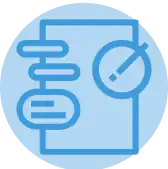
The top sections on a librarian CV
- Professional Summary highlights experience and skills vital for a librarian role, showcasing the candidate's suitability for the position.
- Library Work Experience details previous roles and responsibilities, evidencing hands-on expertise in library services.
- Information Technology Skills show proficiency in library databases and digital resource management, essential for modern librarianship.
- Educational Background outlines relevant academic achievements, including library science qualifications, critical for the librarian role.
- Certifications and Memberships demonstrate ongoing professional development and commitment to librarianship through recognised industry bodies.
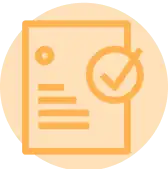
What recruiters value on your CV:
- Highlight your proficiency with library management systems and digital databases, as these are essential tools in modern librarianship for organising and accessing collections.
- Detail your experience with community outreach and programming, as engagement with library users through workshops, readings, and educational events is a key aspect of the librarian's role.
- Emphasise any specialised knowledge or subject expertise you have, since librarians often act as research assistants and need to guide patrons within specific academic or literary domains.
- Reflect on your organisational and archival skills, showcasing how you manage, preserve, and catalogue various types of media and historical documents.
- Include competencies in literacy promotion and information literacy instruction, as librarians are expected to assist patrons in developing research skills and fostering a love for reading.
Recommended reads:
Tips and tricks on writing a job-winning librarian CV header
The CV header is the space which most recruiters would be referring most often to, in the beginning and end of your application. That is as the CV header includes your contact details, but also a headline and a professional photo. When writing your CV header:
- Double-check your contact details for spelling errors or if you've missed any digits. Also, ensure you've provided your personal details, and not your current work email or telephone number;
- Include your location in the form of the city and country you live in. If you want to be more detailed, you can list your full address to show proximity to your potential work place;
- Don't include your CV photo, if you're applying for roles in the UK or US, as this may bias initial recruiters' assessments;
- Write a professional headline that either integrates the job title, some relevant industry keywords, or your most noteworthy achievement.
In the next part of our guide, we'll provide you with professional CVs that showcase some of the best practices when it comes to writing your headline.

Examples of good CV headlines for librarian:
- Lead Academic Librarian | MLIS Certified | Research & Digital Archive Expertise | 10+ Years’ Experience
- Senior Public Librarian | BSc Information Science | Community Engagement Specialist | Children's Literature Advocate | 8 Years
- Technical Services Librarian | Metadata Management | MLIS | Electronic Resources | Bilingual French/English | 5 Years
- Reference Librarian & Information Literacy Instructor | User Education | MA Library Studies | 12 Years in Academic Libraries
- Junior School Librarian | BA English & Information Studies | Emerging Technologies Enthusiast | 3 Years' Experience
- Corporate Research Librarian | Business Intelligence | Competitive Analysis | MLIS Certified | 7 Years Professional Research
Your librarian CV introduction: selecting between a summary and an objective
librarian candidates often wonder how to start writing their resumes. More specifically, how exactly can they use their opening statements to build a connection with recruiters, showcase their relevant skills, and spotlight job alignment. A tricky situation, we know. When crafting you librarian CV select between:
- A summary - to show an overview of your career so far, including your most significant achievements.
- An objective - to show a conscise overview of your career dreams and aspirations.
Find out more examples and ultimately, decide which type of opening statement will fit your profile in the next section of our guide:

CV summaries for a librarian job:
Narrating the details of your librarian CV experience section
Perhaps you've heard it time and time again, but, how you present your experience is what matters the most. Your CV experience section - that details your work history alongside your accomplishments - is the space to spotlight your unqiue expertise and talents. So, avoid solely listing your responsibilities, but instead:
- adverts' keywords and integrate those in your experience section;
- Use your CV to detail how you've been promoted in the past by including experience in the reverse chronological order.
Before you start writing your librarian CV experience section, dive into some industry-leading examples on how to structure your bullets.

Best practices for your CV's work experience section
- Developed and managed a cataloguing system that improved resource accessibility for patrons, leading to a 15% increase in library usage.
- Coordinated and hosted weekly children's storytelling hours that consistently attracted 30+ attendees, fostering early literacy skills and community engagement.
- Curated a diverse collection of resources across various media, ensuring the representation of marginalised voices and promoting cultural awareness.
- Implemented a user education programme that taught patrons how to use digital research databases, resulting in a 25% rise in database utilisation.
- Spearheaded a community outreach initiative which partnered with local schools to enhance students' research skills and library awareness.
- Managed an inter-library loan system with a 98% success rate in obtaining rare materials for patron research and scholarly work.
- Actively participated in regional library consortia, contributing to policy-making and the promotion of innovative library services.
- Utilised social media platforms to promote library events and resources, increasing the library's online following by 40% within one year.
- Conducted regular analysis of library usage statistics to identify trends and inform the strategic acquisition of new materials and services.
- Managed a team of 15 library assistants and librarians, ensuring seamless day-to-day operations and a 20% increase in library patron satisfaction
- Pioneered the introduction of RFID tagging system for tracking books, which reduced misplaced inventory by 35% and improved check-out efficiency
- Coordinated with local schools to implement a summer reading programme, increasing children's library engagement by 50% compared to previous summers
- Established an academic resource sharing network with five neighbouring universities, resulting in a 30% cost saving on academic journal subscriptions
- Developed and delivered an information literacy workshop series, teaching over 2,000 students critical research skills
- Curated a digital archive of the university's historical publications, enhancing the preservation and accessibility of academic heritage
- Reconceptualised the children's library zone, attracting an average of 400 visits per month, a 25% increase over the previous year
- Implemented a bilingual story time in collaboration with the local community, supporting language development for over 100 children annually
- Managed a budget of £30,000 for children's resources, selecting materials that led to a notable expansion of the young reader's programme
- Oversaw the integration of an online library management system that improved book renewal rates by 80%, significantly increasing the efficiency of library operations
- Trained 20 library staff members on the new digital resource platforms, enhancing the team's technological capability to assist patrons
- Conducted a comprehensive digitalisation project, making over 10,000 historical documents accessible to the public online
- Orchestrated the complete refurbishment of the main library, resulting in a 40% increase in library memberships within the first year upon reopening
- Secured £100,000 in funding from various grants for the development of a local history section, attracting researchers and historians nationwide
- Expanded the library's digital services, including e-books and online databases, leading to a 60% increase in digital loan activity
- Designed and implemented a city-wide library marketing campaign, resulting in an increase in library card registrations by 15% over six months
- Formed strategic partnerships with 10 local organisations to host pop-up library events, engaging with over 5,000 residents
- Initiated 'One City, One Book' project, which boosted community reading participation rates by 60% compared to the previous year
- Led the digital transformation strategy for the library, which increased the library's online presence and user interactions fourfold
- Managed the licensing and curation of the e-media collection, achieving a year-on-year growth of 20% in user downloads
- Spearheaded the development of the library's mobile app, which saw an uptake of 10,000 active users within the first year of launch
- Revitalised the library's cataloguing process by introducing automated cataloguing software, increasing processing efficiency by 45%
- Managed the acquisition and processing of over 50,000 library items per year, maintaining accurate records and timely availability to patrons
- Collaborated with IT staff to enhance the library's online public access catalogue, improving user experience and search accuracy
Writing your CV without professional experience for your first job or when switching industries
There comes a day, when applying for a job, you happen to have no relevant experience, whatsoever. Yet, you're keen on putting your name in the hat. What should you do? Candidates who part-time experience , internships, and volunteer work.
Recommended reads:

PRO TIP
Describe how each job helped you grow or learn something new, showing a continuous development path in your career.
Mix and match hard and soft skills across your librarian CV
Your skill set play an equally valid role as your experience to your application. That is because recruiters are looking for both:
- hard skills or your aptitude in applying particular technologies
- soft skills or your ability to work in a team using your personal skills, e.g. leadership, time management, etc.
Are you wondering how you should include both hard and soft skills across your librarian CV? Use the:
- skills section to list between ten and twelve technologies that are part of the job requirement (and that you're capable to use);
- strengths and achievements section to detail how you've used particular hard and soft skills that led to great results for you at work;
- summary or objective to spotlight up to three skills that are crucial for the role and how they've helped you optimise your work processes.
One final note - when writing about the skills you have, make sure to match them exactly as they are written in the job ad. Take this precautionary measure to ensure your CV passes the Applicant Tracker System (ATS) assessment.
Top skills for your librarian CV:
Information Organisation
Cataloguing Techniques
Collection Development
Reference Services
Information Literacy Instruction
Library Management Systems
Digital Archiving
Research Methods
Database Management
Bibliographic Instruction
Customer Service
Interpersonal Communication
Problem Solving
Attention to Detail
Teamwork
Time Management
Adaptability
Continuous Learning
Organisational
Initiative

PRO TIP
If there's a noticeable gap in your skillset for the role you're applying for, mention any steps you're taking to acquire these skills, such as online courses or self-study.
Education and more professional qualifications to include in your librarian CV
If you want to showcase to recruiters that you're further qualified for the role, ensure you've included your relevant university diplomas. Within your education section:
- Describe your degree with your university name(-s) and start-graduation dates;
- List any awards you've received, if you deem they would be impressive or are relevant to the industry;
- Include your projects and publications, if you need to further showcase how you've used your technical know-how;
- Avoid listing your A-level marks, as your potential employers care to learn more about your university background.
Apart from your higher education, ensure that you've curated your relevant certificates or courses by listing the:
- name of the certificate or course;
- name of the institution within which you received your training;
- the date(-s) when you obtained your accreditation.
In the next section, discover some of the most relevant certificates for your librarian CV:

PRO TIP
Focus on describing skills in the context of the outcomes they’ve helped you achieve, linking them directly to tangible results or successes in your career.
Recommended reads:
Key takeaways
Write your professional librarian CV by studying and understanding what the role expectations are. You should next:
- Focus on tailoring your content to answer specific requirements by integrating advert keywords through various CV sections;
- Balance your technical know-how with your personal skills to showcase what the unique value would be of working with you;
- Ensure your CV grammar and spelling (especially of your key information and contact details) is correct;
- Write a CV summary, if your experience is relevant, and an objective, if your career ambitions are more impressive;
- Use active language by including strong, action verbs across your experience, summary/objective, achievements sections.
